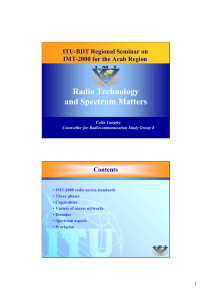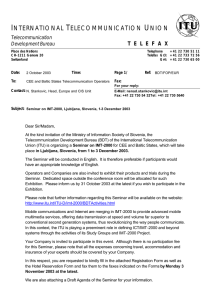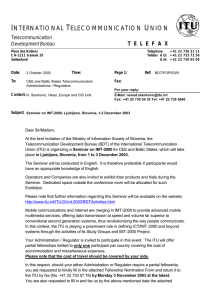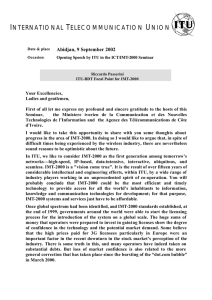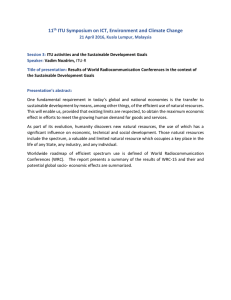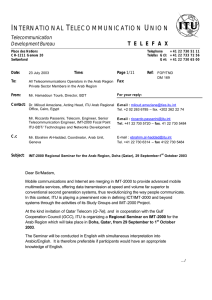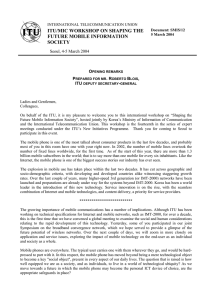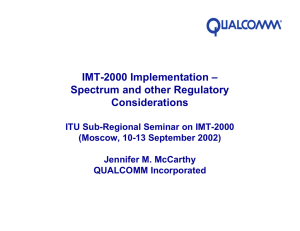IMT-2000 and systems beyond ITU workshop on Ubiquitous Network Societies Colin Langtry
advertisement
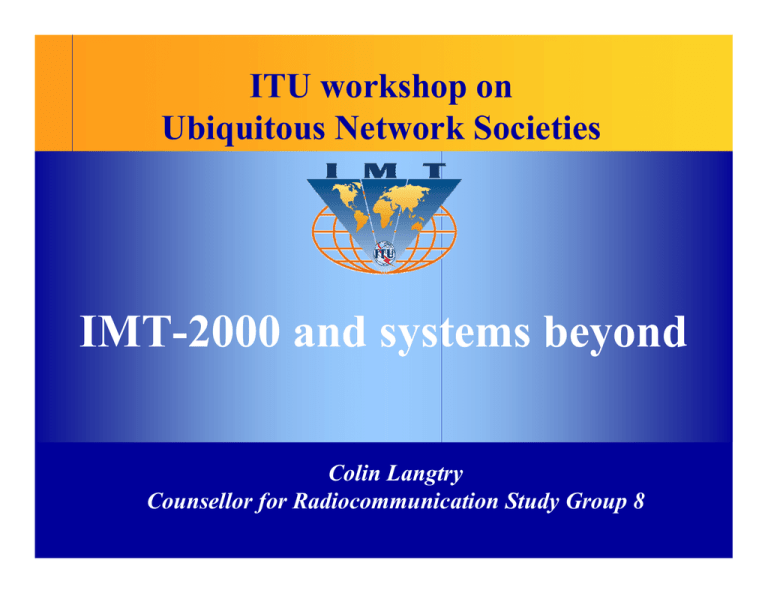
ITU workshop on Ubiquitous Network Societies IMT-2000 and systems beyond Colin Langtry Counsellor for Radiocommunication Study Group 8 Contents • IMT-2000 radio access standards • Three phases • Capabilities • Variety of access networks • Domains • Spectrum aspects • Workplan IMT-2000 Radio Access Standards • A reminder ….. • Designed mainly in response to market, technology & regulatory opportunities & segments • Many of these standards are already being enhanced IMT-2000 Standards Development Forums CCSA ITU Recommendations Standards Development Organizations Consortium & Partnerships ITU Membership Radio Access - Three Main Phases New radio interface(s) i.e. research target 100 – 1000 Mbit/s (full to low mobility) Relationship with other radio systems e.g. Digital broadcast, RLAN, etc. Enhancing IMT-2000 i.e. 2001 “fast packet” up to 10 Mbit/s, 30 Mbit/s by 2005 ? 2010 Capabilities (‘The Van’) Systems beyond IMT-2000 will encompass the capabilities of previous systems Mobility New capabilities of systems beyond High IMT-2000 Enhanced IMT-2000 New Mobile Access Dashed line indicates that the exact data rates associated with systems beyond IMT-2000 are not yet determined Enhancement t Enhancemen New Nomadic / Local Area Wireless Access Low 1 Interconnection 10 100 Peak useful data rate (Mbit/s) Nomadic / Local Area Access Systems 1000 Digital Broadcast Systems Variety of Access Networks New radio interface(s) Research Goals: -100 Mbit/s full mobility Services and applications -1 Gbit/s low mobility New Radio Interface Interface download channel Digital Broadcast IP based Packet based Core Network Cellular 2nd gen. IMT-2000 Wireline xDSL WLAN type other entities Short Range Connectivity Domains Wide Area Personal Area Immediate Area Fusion Recommendation ITU-R M.1645 "Systems beyond IMT-2000 will be realized by functional fusion of existing, enhanced and newly developed elements of IMT-2000, nomadic wireless access systems and other wireless systems, with high commonality and seamless interworking" Spectrum •Need to secure appropriate spectrum to accommodate future requirements This will be considered at WRC-07 o Resolution 802 (WRC-03) o Resolution 228 (Rev.WRC-03) Resolution 228 (Rev.WRC-03) resolves 1 to further study technical and operational issues …; 2 to report to WRC-07 on the spectrum requirements and potential frequency ranges …; 3 to conduct regulatory and technical studies on the usage of frequencies below those identified for IMT-2000 …; 4 to take into consideration the particular needs of developing countries including use of the satellite component of IMT-2000 …; 5 to include sharing and compatibility studies with services already having allocations in potential spectrum …; 6 that WRC-07 should consider frequency-related matters for the future development of IMT-2000 and systems beyond IMT-2000 …, The Plan Systems Deployment New elements to offer capabilities of systems beyond IMT-2000 Spectrum Implementation Framework Other radio systems Requirements Standardization Evolution / Integration with other radio systems Systems Deployment IMT-2000 and future development Spectrum Implementation Enhancements and related development of standards 2006 2009 2012 2000 2003 Indicates that the exact starting point is not yet fixed 2015 Possible spectrum identification at the WRC-07 Possible wide deployment around the year 2015 in some countries WP 8F Workplan 2002 WRC WP 8F WRC preparations 2003 2004 2005 2006 2007 WRC-03 Future Services / Market Analysis 2008 2009 2010 2011 2012 WRC-07 • Draft text for WRC-07: • Spectrum estimate Future Spectrum Calculation Methodology Future Spectrum Estimate • Candidate freq ranges • When Future Technology Assumptions • What for / name Spectrum Survey • Methods to satisfy agenda Sharing Studies • Footnote text • Pooled / shared / paired / etc. ? WP 8F other spectrumrelated activities Radio Aspects 2.5 GHz Spectrum Plan Summary • A coordinated process for standards development is proven (ITU, PPs, SDOs, Forums, etc.) • Flexibility is “designed in” from the outset • Enhancements already being standardized and will evolve considerably over next 10-15 years – open and market led process • Relationship with other radio systems will take place on a market led basis • New radio interface(s) are expected to be required sometime between 2010-2015 • Spectrum aspects will be considered at WRC-07 ITU workshop on Ubiquitous Network Societies Thank you Colin Langtry Counsellor for Radiocommunication Study Group 8

